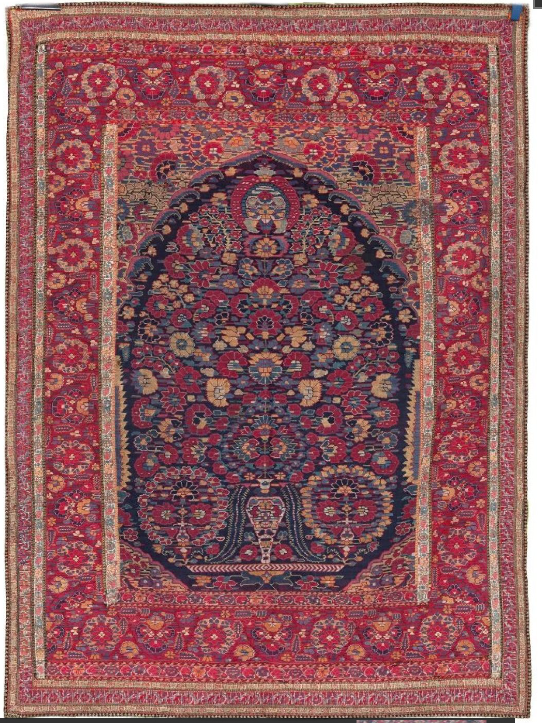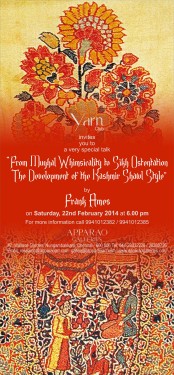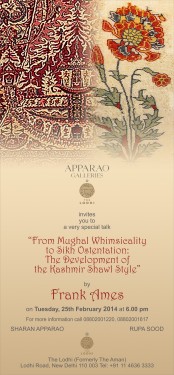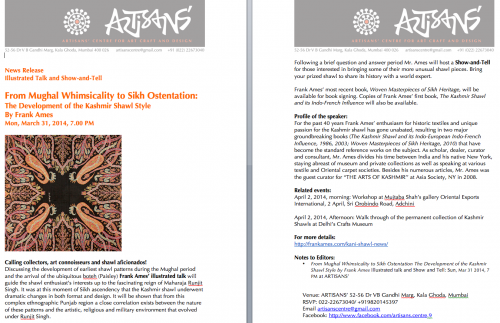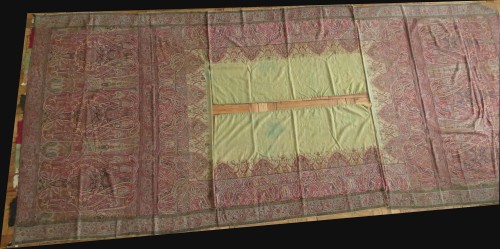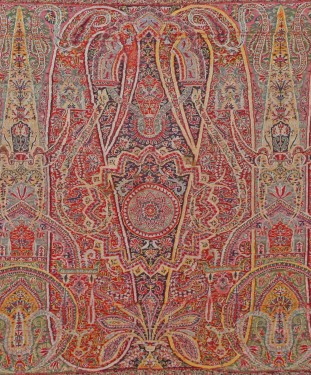Kani Shawl News
CHRISTIES ONLINE SHAWL AUCTION, 11-18 JUNE 2019
Eighty-five rare Kashmir shawls, formerly from the Sam Josefowitz collection of Switzerland were recently sold at Christies’ online auction.. Historically and as a group, it was perhaps the most important sale of such items to have ever been put on the market. From the high Mughal period of the 17thcentury on through the Afghan, Sikh and Dogra periods, each of these eras under which Kashmir was dominated, found significant representation at the sale. Without question, la piece de resistance was the white ground, Mughal boteh fragment, lot 19, selling for over $90,000 (rounded off). However, at the top of the best seller list was the kani mat, lot 17, which sold for an astounding $244,000. It was a small millefleurs-like weaving with a blue-ground central field, each of the corners with a quarter medallion, as in moon shawls though without the central medallion. Whether the bidders were aware of the extensive damage it had suffered and its lack of provenance, I don’t know, but there was certainly nothing in its aesthetics or history to justify such a price. Lot 55, an embroidered rumal with figures, was the next unexpected big winner, selling for $53,000. Despite its rather shabby condition (large areas of wear, faded colors and extensive loss of embroidery) its fine artistry, painterly vegetation and early date, flickered and twinkled enough here and there to cause serious interest. On Lot 1, a fine dorukha, its beauty and its excellent condition along with its solid wool foundation propelled its price to $39,000. Such numbers are not unheard of in India where appreciation of the dorukha has over the years driven their prices up, in some cases astronomically. The eye-dazzlingly black ground moon shawl (lot 4) with sunburst (shamsa) pattern was in my mind one of the most brilliant graphic designs ever to find its way into a kani rumal. It had been hanging in my living room for a few years before it found its way into the Josefowitz collection. What most are not aware of is that the black ground had been painted in. It took me the better part of a few hours working with various strength magnifying glasses to ascertain this fact. This just goes to prove how meticulous, of not ingenious, the weavers were. It was a bargain at $17,000. Setting price records again we turn to the Sikh period: two very nice, long shawls, quintessential specimens, one with imposing peafowls repeating across its pallu (lot 25, $27,500) the other squiggling with snakes and vines and complimented with an eight-leaf, white kani center of powerful proportions (lot 61, $32,500). The former, for sure a product of the 1830s: the peafowl motif had been copied off Indian shawls by the well-known French manufacturer, Hébert in 1839.
The late Sikh, zoomorphic long shawl in lot 10, was a masterpiece in weaving and deserved the hefty price paid for it ($28,500). Its design might have been the inspiration for the French shawl designer to initiate his famous jungle foliage patterns of 1848-1850. Featured in my book, Woven Masterpieces of Sikh Heritage, the rumal in lot 57, the pattern to which I liken it recalls the dizzying holographic effects of a spinning propeller, also set a record for a rumal ($32,500). As a work of art, it’s unsurpassed with nuanced tones and brilliant bull’s eye center. For the astute buyers, there were bargains to be had as well. Lot 62 ($12,000), a beautiful early 18thcentury jamawar, in great condition, replete with its original hashias and diapered pattern of excellently drawn buti flowers propped on a tiny mound. The red ground rumal in lot 84 ($3,000), in my estimate was at least as important as the ‘propeller’ one. There were three narrow stripped moon shawls -Sam loved moons shawls- all circa 1800 that went for strong prices, especially lot 83 which sold for $28,500. Lot 15, a complete dochalla from the 17thcentury, despite its fading, poor condition and weak design, hammered down at an surprising $53,000. However, buyers are aware these days that complete 17thcentury Mughal shawls have virtually dried up. Three other rumals (Lots 36, 43,45), aesthetically not much more than garden variety, drew paradoxically strong hammer prices: $9,000; $4,400; $4,400. Any collector worth his salt would have completely ignored them. Lot 73 was a finely wrought reversible (dorukha) rumal, c 1870, of which very few exist. It’s similar to a pair in the Cooper Hewitt Museum. This one went for quite a fair price of $20,000. Overall, the strong prices attained sets the bar quite high for future sales even if the majority of the buyers still remain anonymous. This sale is even more surprising given that Skinner’s Auction has, over the past decade, been the preferred place for dumping quantities of Kashmir shawls on a weak market where buyers have snapped them up unapologetically. Exception being a saffron ground, moon shawl selling 6 years ago for $65,000.
Care to comment?
Please reply via ‘contact’ page. Thanks
“OBIT”: CHRITIE’S SOUTH KENSINGTON IS CLOSING DOWN
This is indeed sad news for all dealers and collectors of antique textiles. Some of the most interesting pieces used to come up for sale there. It was such a great place to wade through piles of textiles coming from the four corners of the globe. And needless to say some of the best Kashmir shawls came under the hammer there. For dealers sitting on old inventory collecting dust it was an easy place to recycle dead wood and pocket some money. But as society moves rapidly into the 21st century, the hidden closets and musty attics of those who had worked for the East India Company, returning to England after years abroad in Asia, with collections of accumulated exotic textiles, those storage places have dried up. For dealers in this trade the halcyon days were the 1970s, 80s 90s and even up to 2010, but as the century turned and the internet took over and the auction houses raised their commissions- many of them now approaching 30%, it became increasingly clear that the smaller dealers were being pushed out or being extremely careful in purchasing or selling through auctions. SK also provided a venue for like dealers to get together, trade stories, meet new people, collectors, even if they felt like later on they had to tussle over auction bids.
The advent of websites specializing in antique textiles also became a challenge to the auction houses. Christie’s and Sotheby’s have virtually ceased their specialized sales of carpets and rugs. The turnover of auction house specialists that went off on their own business ventures meant that auction client lists were no longer secure. The explosion of social media meant that dealers and collectors can now connect quickly. Its only in the last 30-40 years that a plethora of specialists books on textiles have become available. People tinkering with the idea of collecting can now arm themselves with detailed knowledge. Easy access to past auction results is there at the click of the mouse. The large antique shows are also fading. New York’s famous Triple Pier show is gone. Dealers were paying increasingly large fees for a booth only to sell to old clients whom they could have easily sold to without the hassle or expense of setting up a booth.
SKINNER AUCTION
FINE ORIENTAL RUGS & CARPETS
SALE 3004B, 25 APRIL 2017, BOSTON
Lately Skinner has been selling a good quantity of Indian Kashmir shawls in each of its past rug auctions and this time twelve were presented. A late Dogra period one, lot 75, with a kind of rug design layout went for $1968, while lot 71, looking rather finely woven, with a black and blue center went for a rather surprisingly low price of $1169. The “Mughal” shawl panel, with an Islamic manuscript pattern went for $2706, a modest sum considering its rarity. It was a piece I bought more than 30 years ago.
The off-white moon shawl was nice if a bit stiff with it’s rather boring mosaic patterned center and quarter medallions. However, its ripe age of circa 1800 made it desirable to collectors ready to fork over $6765.
The last shawl to be sold was lot 76. Enigmatically it sold for a rather high price considering its quality was nothing to brag about. Its blue center was refreshing and the weave appeared to be quite acceptable but so was Lot 71. More strangely was the fact that the time spent on its bidding lastly not more than 20 seconds. From the opening price of about $1000 it jumped to its final bid of $3250 (+ comm), before the hammer abruptly came down. Correction: Just learned that this piece was not sold! Now that makes sense.
As most collectors know by now the main driving force behind the pricing of these Kashmir shawls are the Indian dealers who frantically search high and low for them in Europe and particularly in France where most of them hang out. There probably hasn’t been one French antique dealer who hasn’t yet been harassed by the incessant if not cloying demands of these mostly Delhi/Gujarati dealers. the mighty Dollar for the past 5 years at least has been trashing the rupee. As a result, Indian dealer decided that it was just too expensive for them to travel all the way to the US. Besides, finer shawls always seemed to pop up in France.
If you add to this phenomenon, the Demonetization that recently took place in India, It all added up to the perfect storm for crashing the kani shawl trade in India, not to mention a thousand other types of cash businesses that depend on the free movement of currency.
ART RICHELIEU AUCTIONEERS, PARIS
TEXTILE L11, DROUOT, Wednesday Avril 2017
This was a sale of various and sundry textiles from around the globe with an emphasis on period French costumes, lampas, palampores and Kashmir shawls.
Lot 233, an Indian long shawl with a central roundel split sharply into to solid colors of blue and white, hammered down at 2000 euros or 2540 with commission. It’s a shawl I had once owned or it just might have been it ‘dochalla double. Whatever be the case from having owned it many years ago I can still recall the quality of its weave, which was not that good. On a scale of ten, perhaps it was an 8 at the most. Besides its nicely worked center there was nothing in its design that would make it stand out.
The long shawl that did reach a decent level was Lot 235. The hammer plus commission came to 3937 euros reflects its fine array of rich, early 19th century colors, wonderful snaking pattern recalling patterns developed by Antony Berrus and which became very popular during the latter years of the 1840s. This would not be classified as a Sikh period shawl, though. My guess is that it was woven in the succeeding decade.
Lots 232 and 237, 1270 & 1397 euros respectively were more of the ‘garden variety’.
Lot 231 was a rumal with a star black center, pleasant design, nice colors and from what I can tell from experience just by looking at it on the web, an excellent weave. It went for about $1100.
A nice white centered long shawl form the first half of the 19th century, one of those monochromatic garden varieties of what I call the ‘Moorcroft’ pattern of stout Paisleys that monotonously shoulder up across the
the pallus, hammered out at 3556 euros with comm. Its white matan with the needleworked kunj botehs and central matan escutcheons certainly enriched its allure to perspective buyers.
Bare in mind that I have not seen these pieces in person and am therefore unaware of the amount of deterioration they might have suffered: holes, tears, rips, rotting, fading, stains, etc.
Nemati Collection Auction sale 11 April 2016, Paris
About 115 shawls, Kashmiri and European, will go up for sale in Paris, the large majority of which are the ‘garden variety’ types. That is to say they are the most frequent types, encountered at flea markets and antique shops. Some body spent a ton of money to produce a glossy catalogue for common Victorian shawls most of which will struggle if not fail to reach even their low estimates. Nevertheless, a few do stand out such as the two 1830 moon shawls one of which appears to possess an attractive green ground color. Whether the photo had been Photoshopped is another question. Five other moon shawls are in the sale as well as a rare prayer niche kani shawl, lot 88, (3.3 x 4.5 feet; est. 5-10,000 euros) which I had published way back in 1986 ( see reprint 2003, p312, CP181). A nicely drawn vase sitting on a chevron edged dish, supports a huge spray of multitudinous flower blossoms. Three large ‘ferris wheels’ of flower buds form the bottom and one at the pinnacle bespeak of a radial style that became most popular during the second half of the 18th century. A late 18th century date would not be out of line for this piece. Its outer red border, quite mosaic in character, might hint an early 19th century date but one could conceivably understand that this might have been a later addition. Certainly the narrow silk ground hashes have a good age and my guess is that most of the shawl weaving, except for the outer border, was done all on the same loom and in one piece. Naturally without seeing it in person and inspecting the reverse it’s impossible to state with certainty that a seam doesn’t exist some place.
The big problem with these overall reddish prayer mats is that they lack aesthetic appeal, especially ones whose flowers are for the most part geometricized or one could almost say pixelated. However at this low estimate there will be many bids and should provide a much needed boost of adrenaline for the rest of the sale. Three other lots are worth mentioning which will surely bring big money compared to the puny shawls being offered. Mughal patch or waistband end with six imperial style poppy blossom on gold silk ground, lot 126. the Armenian needlepoint from Karabakh whose size was given as 12 x 3.3 feet -obviously a typo for the length, which in my estimate should be approx. 5 feet- has been estimated at between 40 and 60,000 euros. And finally a small but significant 16/17th century Safavid fragment with full length princely figures and their attendants in a garden of flowers, with an estimate 8-10,000 euros.
SKINNER’S AUCTION
Sale: March 13, 2016
Skinner’s sold about 25 shawl items from their Boston auction room. It was primarily a rug sale but since Lawrence Kearney, expert in charge, has a connection with an obviously motivated client with a large collection of shawls it was decided to test the market waters. Overall there was nothing of high historical interest or irresistible novelty. From the first group of shawls, a Sikh period moon shawl (lot 26) with a white ground, estimated $2000-$25000 went for just about the higher estimate (w/o) commission.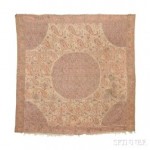 Four went unsold. Among the second group, a late 18th c. white ground moon shawl, lot 78, est. $4000-$5000, didn’t even reach the lower estimate but sold anyway for $4305 (inclu. comm.). Whoever bought it got the best deal. While it’s botanical details left a lot to be desired, its early age was apparent by the diminutive size of the central medallion and narrow hashias (borders). Probably what kept the price low was the poor condition of the borders. As far as the rest of its condition, a catalogue photo rarely reveals the extent of damage.
Four went unsold. Among the second group, a late 18th c. white ground moon shawl, lot 78, est. $4000-$5000, didn’t even reach the lower estimate but sold anyway for $4305 (inclu. comm.). Whoever bought it got the best deal. While it’s botanical details left a lot to be desired, its early age was apparent by the diminutive size of the central medallion and narrow hashias (borders). Probably what kept the price low was the poor condition of the borders. As far as the rest of its condition, a catalogue photo rarely reveals the extent of damage.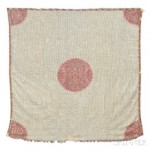
The third group comprised a few late 19th c pieces of lackluster interest. The long white shawl (dochalla), lot 133, est. $3-4000 went for $3075 (incl. comm.) which means it never reach its lower estimate. (Above photo). These are what I called the Moorcroft booth types from around 1823, the time when the latter sent back to England a group of shawl drawings in this same vein.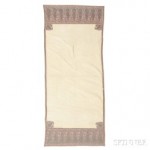
One lot that I particularly liked was a pair of end panels (pallus), nicely drawn from around 1815, which if they had been well illustrated in the catalogue might have surpassed the very reasonable price they attained of $1845 (incl. comm)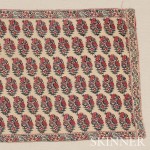
CHRISTIES AUCTION– 9 Oct 2015
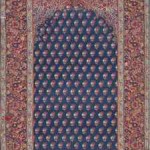
Lot 139 achieved a rightly deserved price. Highly collectible, these prayer niche types are usually woven all in one piece. At 28 x 43 inches, its compact size, lends it easily to displaying as a work of art and makes it a choice item for collectors of oriental rugs and Islamic art. But they also have a transcending, timeless quality that make them very appealing to people in the arts in general. The ‘stars’ diapering the midnight blue field gives it a cosmic feel.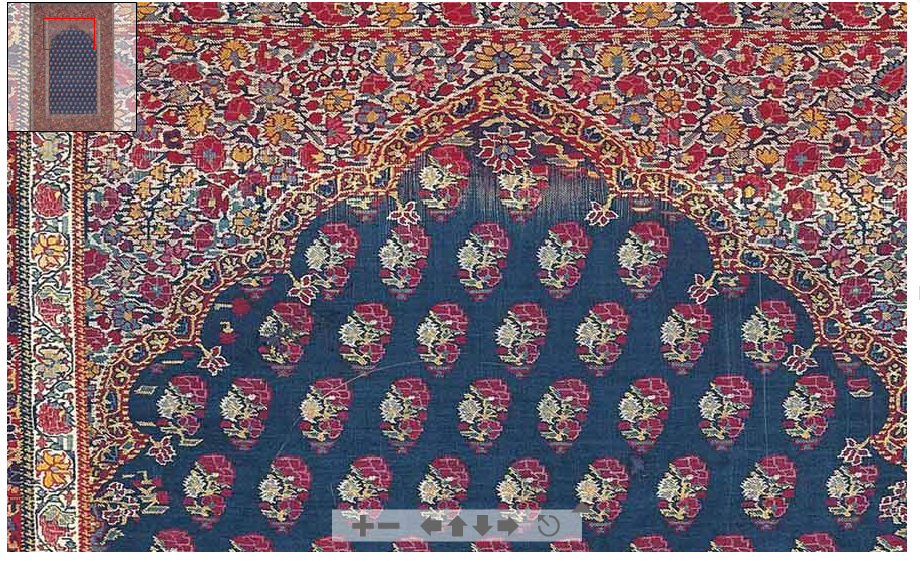
The spandrels were not very well woven but the rest of the weaving glistens with bright blossoms and scattered racemes. Judging from the botanics of the flowers its age is definitely well into the 18th century, perhaps as early as 1750 or so. Whoever bought got a wonderful piece.
Recently a ‘new’ map shawl was discovered. Up until now only four map shawls were known to exist. While in many ways they all resemble each other insofar as they all depict the topology of Srinagar, each possesses its own embroidered charm of colorful tints and landmark embellishments of this famous city nestled at the foothills of the Himalayas. Although the V&A’s is the most widely known simply because it has been exhibited so often and published, the National Gallery of Australia’s is perhaps on par as far as workmanship, colors and technique of embroidery. The British Royal Collection owns the third but its rectangular format gives it an odd appearance and I have yet to view any details of it. Rosemary Crill published a not so appealing photo of it in Hali 67 (1993. The fourth is in the museum of Srinagar suffering a terrible fate of abandonment to the vicissitudes of dampness and heat and when I last visited the museum, way back thirty years ago birds were scooting in and out of missing windows!
Measuring 73 x 72 inches, basically square, it contains dozens of Persian inscriptions identifying the various gardens, lakes, buildings, mosques, etc. of the town. I’ve counted at least 15 different colored yarns but there seem to be many more depending on the subtleties of shading employed. Embroidered all in fine pashmina, the needle work is of the highest quality. It’s whereabouts unfortunately cannot at this time be divulged.
This recent discovery is a monumental addition to the what was up until now rather limited repertoire of such embroidered maps. Apart from Rosemary Crill’s informative article in Hali (1993) wherein she describes the V&A’s magnificent map shawl, no one has yet really done an in-depth study of them. Perhaps this new addition will find new eager scholars willing to undertake the task. Even without understanding the social context in which they were created, the complexities of the embroidery has yet to be analyzed by experts. I feel that the embroidery for each of the map shawls varies to some degree however this one is done in a true embroidery technique, not needlework like the V&A or Australia’s map shawls, a technique certainly involving more intensive work. To understand better this needlework, anyone with an early dochalla should take a close look at the kunj or corner field botehs which were always done with this technique. Usually it was done also with the dorukha technique where one finds the ground color changed from one side to the other, a kind of flat couching stitch.
============================================================
To Sikh or not to Sikh
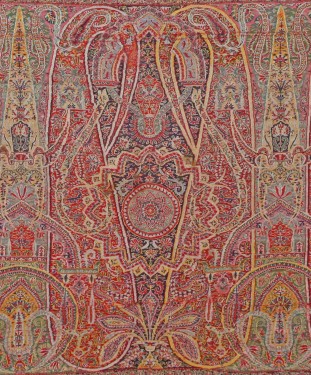
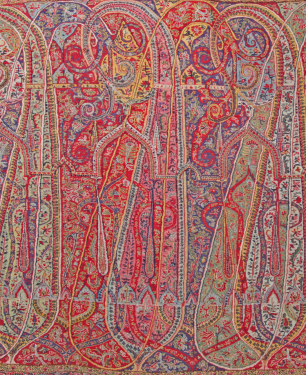
The Argument:
In my first book The Kashmir Shawl and its Indo-French Influence (1986), I had established a system of four categories or periods if you will that I felt helped define and classify the multitude of shawl patterns. Control of Kashmir during its four hundred year history of kani weaving began with the Mughals; Afghans, Sikhs and Dogra followed in succession right up until what’s considered the demise of the Great Shawl industry, about 1880.
In 2010 my second book came out, Woven Masterpieces of Sikh Heritage which delved much deeper into the evolution of style and the forces that shaped it under Maharaja Runjit Singh.
In my work I argue that a special shawl style indigenous to the Punjab came about that was based not on or necessarily influenced by European shawls. A style that found its roots in the fertile soil of the Punjab, an art style nurtured by the Sikh Brotherhood of the Khalsa movement and an autonomous culture that was in many way not part of typical India but isolated in a region cordoned off from the rest of the subcontinent by very specific boundaries, the Sutlej River (cis-Sutlej) where one side was ruled by the British, the other, the Land of the Five Rivers, by the Sikhs under Runjit Singh.
Nevertheless despite my work in this area, a few textile experts have expressed doubts. They feel that the Sikh style derived from European Jacquard woven shawls that had been designed by French artists; moreover, that most of the basic designs evolved before the Sikhs took political control of the Kashmir Valley.
In this essay my aim is to demonstrate the fallacy of this belief.
During the late 1820s and early 1830s in the Kashmir/Punjab region of Northern India a certain strain of bizarre patterns began appearing on the kani woven Kashmir shawl. This curious strain comprised geometric shapes of sweeping curves and arches, architectural devices that resembled indistinct buildings, blossom arrangements of pyrotechnic-like displays, skeletal botehs (paisleys) and stars and lobed circles indented with spear-like tree devices, recurve bows, quivers filled with arrows, shields, boats, and even daggers, to name a few. The confluence of these design ideas woven into the kani shawl is what I call in my publications the Sikh Kashmir shawl. Looking at the patterns, however, one’s opinion can only be drawn to a stark non plus since although the patterns are frequently awesome and majestic there is nothing inherent in their designs that could be equated with contemporary shawl designs being jacquard-woven in Europe. In fact, it is extremely difficult to equate them with any earlier form of known artist style or movement. The patterns are truly unique. However and despite any proof, there remain a few skeptics who refuse to align themselves with this train of thought. Their contention is that they see European influence as the driving force behind these bizarre patterns, that somehow Kashmiri artists were being exposed to shawl designs such as those being wrought by the well-known French industrial designer like Amedée Couder, or for example the Parisian manufacturers Bournbonet and Chambellan&Duché, and had set about copying them into their kani weavings in Srinagar.
But the European designs of the 1830s that illustrated architecture were also extremely fresh and new to the market. In fact, so novel were they that extremely few have ever been found. On the other hand, Couder’s Ottoman or Byzantine style Isfahan shawl of 1834 was frequently found woven as well as related patterns that imitated it to some degree. Bournhonet’s Gothic shawl ideas didn’t make it into ‘print’ so to speak until 1839(see p. 80 of MLS). All this to say that if these Gothic architectural designs were indeed so popular as the skeptics imply, then why is it that not one Indian Kashmir shawl has ever been found with a replication of these patterns for the Western market?
As a concession to the skeptics argument I will concede that it’s not impossible that a few of these Gothic Jacquard shawls had traveled to Kashmir where upon the local artists, not understanding the complexity of the designs nor the social implications of the church-like architectural structures, set about creating their own “Gothic” style. But wait: The skeptics continue to decry that these “Sikh” period shawls were for export! So here lies the fallacy of their argument. Export markets exist only if there is a demand.
Again, we ask: From where did the skeptics derive their information and on what grounds do they support their argument?
Another concession I’ll grant but one that has no little bearing on design is the format of the shawl. For sure the demand for a larger wider long shawl compelled the Kashmiris to make theirs bigger. But back to the main argument.
These particular European designs of building façades were Gothic in nature ( known as ‘renaissance’ shawl in France) and our knowledge of them is derived solely from a few illustrations in a French publication, ALBUM DU CACHMIRIEN BY F. Chavant, and an exceptional woven example (V&A, no. T.362-1980, see p. 81 of M. L-S). Except for Couder’s Isfahan (Bizantine style, 1834) and his famous ‘Nou Rouz’ (Gothic style, 1839), shawls which have been often found Jacquard woven, Bournbonet and Chambellan&Duché’s Gothic shawl designs are known only extremely rarely. The Isfahan of course is the earliest shawl exhibiting strong architectural elements; and many related shawls – invariably square shawls and almost all from the Couder atelier-are known. Their patterns exhibit an elaborate baroque style leaning more towards ecclesiastic Byzantium and far removed from any of the known bizarre (Sikh) patterns coming out of India.
In my forty years as a Kashmir shawl dealer half of which were spent living in Paris and my constant travels throughout Europe and India and my frequent contact with the best collections in the world as well as buying and selling thousands of fine pieces, I have never seen a Kashmir shawl pattern based on any of the architectonic French models. And the reason for this? NO EUROPEAN DEMAND. Monique Lèvi-Strauss herself admits that the vogue for these ‘renaissance’ shawls was short lived.
Furthermore, on the flip side, I have never seen any European shawl exhibiting the Sikh motifs in question indigenous to Kashmir of this period, except for those which were exact duplicates –of which many can be found- of those kani woven in Kashmir. The skeptics contend furthermore that since none of these bizarre patterns can be found in contemporary painting, either in India or in Europe, the source of their design must have come from abroad and not India. It’s true that there’s not one known Indian painting that illustrates a Sikh shawl. But this cannot be taken as a measure of its lack of popularity. The Hungarian painter, August Schoefft, in his monumental painting of the court durbar of Maharaja Runjit Singh illustrates very clearly two long Sikh Kashmir shawls employed a curtains in this highly animated scene. Indian artists were not likely to paint a strange new fashion, one insular to a region cut off from the rest of India. Let me point out one important thing. The Sikh designs we are talking about here represent a an extremely narrow segment of a shawl industry known for a seemingly boundless repertoire of shawl designs. One might describe it as a very special artistic movement, albeit short lived, but perhaps not unlike the movements of Cubism or fauvism, both of which had only brief periods of popularity. And like these French movements, the Sikh movement also had its impact on future shawl style.
There are not that many archival sources or references to French patterns of the early 19th century. Besides Couder’s 1823 sketch of a long shawl that shows the seminal beginnings of a miner architectural device such as the running pattern around the shawl’s center field, of tiny mihrabs, there are also the sketches to be found in Chavant’s publications of shawl designs wherein we find a Gothic design done in pashmina by the manufacturer Bournbonet and another one exhibiting a type of Byzantine architecture layered with an overall feeling of Chinoiserie. Both shawls had been exhibited at the Exposition des produits de l’industrie Francaise of 1839.
Monique Lévi-Strauss’ book, illustrates from “Souvenir de l’Exposition de 1839” from the shawl manufacturers Chambellan and Duché, a quarter section sketch of a square shawl, half painted in, of what is clearly and stylistically an already sophisticated Sikh pattern (p166) drawn directly from an imported Kashmir shawl.From the same album, Frédéric Hébert & Co, shows stylistically, a very similar pattern (p207), though featuring a peacock. Not only were both patterns obviously taken directly from Indian shawls, but Lévi-Strauss points out herself (p202) that “The only Hébert design not inspired by Indian models was the shawl known as The Dendera. And this is quite true of just about all shawl manufacturers who had to satisfy an extremely demanding market where competition was fierce. Fashion conscious clients would not accept anything that wasn’t truly Indian in style or nature.
Now the question arises: Did the French have agents stationed in Kashmir, at the ready, to capture such patterns in kani weaving for the French market? And if they did why is it that no such shawls (either Byzantine or Gothic in style) have ever been found in the market? I have yet to come across a kani shawl exhibiting any such pattern.
It is possible to speculate that the Kashmiri weavers, having seen such Baroque European shawls with their fancy architectural devices, scratched their heads and decided that this was too bizarre, instead they set about doing their own cultural thing and taking ideas from their homeland, the Punjab, the Sikh Brotherhood, the Khalsa, etc.
The Sikh Punjab was not part of India. It was an autonomous region rule by a great Maharaja. The region did not follow in the footsteps of an India which was not yet a nation!
My belief is that these patterns were the creative and exclusive products of a group of very talented Kashmiri/Punjabi artists who drew their inspiration from their own culture, their land, their religion, where they lived and the social environment that formed their outlook on life. The list of items mentioned above all point to this.
I invite comments to this essay.
Please go to “Contact” on the main menu.
====================================================================================================
Three of the evites to my previous talks in India during the months of Feb and March, 2014:
+++++++++++++++++++++++++++++++++++++++++++++++++++++++++++++++++++++++++++++++++++++++++++++
A Note on Understanding Sikh Shawl Construction
Recently a knowledgeable client of mine requested some not-so-often-asked-for details of an interesting Sikh period long shawl I have ( see no. 163 under Kashmiri Shawls). To find the answers, which I must admit baffled me at the time, required some serious hands and knees investigation into the exact piecing of the shawl. Close inspection of the fringes revealed something remarkable which I hadn’t seen on any other shawl. In my ‘fringe’ experience over the past 35 years I’ve always seen the classic solid-color tabs of the Sikh shawl sewn on to the pallus of the kani weave. However, here I discovered a very unusual, if not exciting anomaly: each of the tab colors had been inserted as an extension of the weave. If you’ve ever lent serious attention to many of the seamed classic dochallas, or long plain-field shawls that were popular until about 1830 you’ll often see how they were ‘invisibly’ pieced together by enmeshing the warps of one half with the other. It’s an absolute miracle how this was done; today, a lost art. This is the exactly the same process employed in attaching these tabs. Another question had me comparing the piecing of one end (pallu) of the shawl to the end. One side was 3 inches shorter that the other with Paisley heights differing by 2 inches. But overall of course the shawl otherwise doesn’t in the least appear unbalanced since any difference was made up by the sizes of the two kani panels comprising the pallus, which measure approx. 12 and 24 inches each. So how many pieces of kani shawl did the rafugar actually get before he pieced the whole thing together? The red center woven with its ‘door’ or edge-running pattern is one; the long-running side pieces flanking the center make two; the two kani panels making up the pallus at each end make four; the two long hashias (with white silk warps) make two. Nine kani woven pieces altogether not counting the plain woven fringe tabs. This should be the right count for finely woven Sikh period shawls. One should bare in mind that Sikh shawls predate the patchwork kani products by at least a generation. Knowing how a shawl is pieced together is of fundamental importance in learning about its manufacture and aesthetic qualities as well, and in the process of studying it along these lines there will invariably be interesting things to discover. I cannot stress how important it is to compare one end of a shawl to the other, noting the use of different colored threads, variations in design and rarely but sometimes a completely different flower might show up. This goes for all shawls be they Mughal, Afghan, Sikh or Dogra. It all boils down to taking a serious look into shawl construction.
